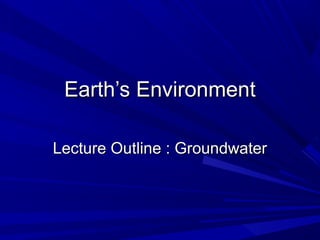
Groundwater Notes - Earth's Environment
- 1. Earth’s Environment Lecture Outline : Groundwater
- 2. Where is the water on Earth? Look at the next slide’s diagram. In it you’ll see that most of the water on Earth is salt water. Out of the fresh water, most is frozen. Groundwater makes up the largest portion of fresh, liquid water on Earth.
- 4. Where is groundwater and how does it get there? The Water Cycle shows us how water moves from phase to phase (gas, liquid and solid) and from place to place on Earth. Water that infiltrates into the earth becomes groundwater.
- 6. Where do you find groundwater? Groundwater can be found in between individual pieces of sediment in a layer of unconsolidated material (not solid rock, but layers of sand, gravel, silt, etc.) Groundwater can also be found in the spaces that exist within solid rock. – Either pore spaces between individual grains – Or in cracks that exist in solid rock
- 7. Intergranular = pore spaces in solid rock or unconsolidated material Fractured bedrock = cracks in solid rock Solution enhanced = cracks that have been enlarged by groundwater dissolving rock
- 8. Types of Aquifers An aquifer is a layer of sediment or rock capable of holding and transmitting significant quantities of water. Aquifers that have an impermeable layer above and below them are called “confined aquifers” What’s an impermeable layer? A layer of rock or sediment that doesn’t allow water to flow through easily.
- 9. Unconfined aquifer Also called a “Water Table” aquifer, this type does not have an impermeable layer above the aquifer. See the next slide for a diagram showing two confined aquifers and one unconfined aquifer.
- 10. The Confining beds are also called aquitards. They retard, or slow, the flow of water.
- 11. Other terms The water table is the top of the saturated zone. The saturated zone is the layer in the aquifer where every pore space or every crack is completely filled with water The unsaturated zone exists above the saturated zone, and may have moisture, but the pore spaces or cracks also contain air.
- 12. Vadose zone and zone of aeration are other words for the unsaturated zone. Water from the saturated zone can move upward through capillary action into the unsaturated zone.
- 14. Water table divides the two zones. The position of the water table will vary. More recharge raises the water table.
- 15. Source of water – Unconfined In an unconfined aquifer, water will seep into the ground directly above the aquifer. This is the recharge area.
- 16. Source of water - Confined In a confined aquifer, the overlying aquitard prevents water from the surface from seeping into the aquifer. Recharge, therefore, often comes from far away, in a place where the aquifer meets up with the surface. See the illustration on the next page.
- 19. Groundwater entering the ground = RECHARGE Recharge comes from direct precipitation Or snow melt Or, in certain situations, it can come from a stream
- 20. Precipitation
- 21. Streams as a source of groundwater recharge (mostly in dry climates) In locations where the water table is below the bottom of the stream, water from the stream can run into the ground and feed the groundwater. This is called a losing stream or an influent stream.
- 22. Induced recharge into wells from streams There are some situations where, even in humid climates, water from streams ends up in wells. This occurs when a pumping well is located in an aquifer near a river. Water from the river is pulled into the pumping well. These tend to be very productive wells – there’s a constant source of water. However, it is river water, albeit, filtered through the ground, but there can be quality issues.
- 23. Streams feeding groundwater through “Induced Recharge”
- 25. Groundwater Discharge Groundwater can be discharged from the aquifer either through a – Pumping well – Or a stream
- 26. Pumping wells lower the groundwater through “drawdown” Drawdown often forms a cone-shaped depression around the well, called a “cone of depression.”
- 27. Groundwater is also discharged into surface streams, wetlands and lakes (in humid climates).